A Comparison of Convective and Stratiform Precipitation Microphysics of the Record-breaking Typhoon In-Fa (2021)
Abstract
:1. Introduction
2. Data and Methods
2.1. PARSIVEL Disdrometer Network
2.2. GPM DPR Data
2.3. Disdrometer Data Processing
2.4. Rain Classification Method
2.5. Hydrometeor Recognition Method
3. Results
3.1. Analysis of Atmospheric Circulation
3.2. Precipitation Microphysics from Disdrometer Data
3.2.1. Overall DSD Characteristics
3.2.2. DSD Derived Relationships
3.3. Radar Quantitative Rain Rate Estimation
3.4. Statistical Assessment on GPM DPR
3.5. Precipitation Microphysics from GPM DPR
3.5.1. Vertical Precipitation Structure
- Beneath the height of 5 km, ZKu increases rapidly towards the ground (from 30 dBZ to 35 dBZ) in the convective region, which reflects the dominant collision and coalescence process of raindrops. Compared to that, the increase of ZKu is relatively less distinct in the stratiform region (only from 26 dBZ to 28 dBZ), which is related to the collision and breakup process of large raindrops.
- From 10 km to 12 km, ZKu increases sharply as altitude increases (from 16 dBZ to 23 dBZ) in the convective region, which reflects the active cold-cloud processes (such as aggregation, riming) that contribute to the growth of solid particles. Compared to that, the increase of ZKu is hardly noticeable in the stratiform region (only from 17 dBZ to 17.5 dBZ), which reflects the weak cold-cloud processes in stratiform rain.
- To confirm the specific microphysical processes occurring at different vertical heights, it is necessary to identify the distribution of specific hydrometeor types. Hence, in the next section, we further retrieved the hydrometeor distribution within Typhoon In-Fa.
3.5.2. Hydrometeor Distribution
4. Discussion
5. Conclusions
- Compared with the typhoon convective precipitation in Hainan and Taiwan, the precipitation measurements of Typhoon In-Fa over eastern China show larger (smaller) raindrop concentration (Nw) than that of Taiwan (Hainan), and the raindrop diameter (Dm) is the smallest in eastern China while largest in Taiwan. Moreover, the typhoon convective precipitation measured in eastern China and Hainan is more maritime-like than precipitation in Taiwan possibly due to the difference in topography.
- Convective rain has a much higher raindrop concentration (larger Nw) than stratiform rain due to more graupels melting into liquid water while falling. Large raindrops occupy most of the region below the melting layer in the convective region due to a dominant coalescence process of small raindrops (featured by larger ZKu, Dm, and smaller N0, µ, Λ), while small raindrops account for a considerable proportion in the stratiform region, reflecting a significant collisional breakup process of large raindrops (featured by smaller ZKu, Dm, and larger N0, µ, Λ).
- GPM products are validated against networked PARSIVEL observations for both convective rain and stratiform rain in Typhoon In-Fa. It is suggested the normalized bias of convective rain (16.3% for rain rate and −0.27% for radar reflectivity) is much less than that of stratiform rain (57.2% for rain rate and 19.6% for radar reflectivity), indicating that GPM product might have better performance for convective rain than stratiform rain of typhoon over eastern China. Even though, more typhoon case studies are needed for further clarification.
- The standard Z-R relationship (Z = 300R1.40) used in NEXRAD generally underestimates the rain rate in Typhoon In-Fa. The default R-Dm relationships in the GPM official product slightly underestimate the drop diameter in Typhoon In-Fa. Native Z–R (Z = 124R1.57 for convective and Z = 197R1.47 for stratiform) and R–Dm (R = 2.513Dm4.109 for convective and R = 1.146Dm5.011 for stratiform) relationships are thereby derived to improve the quantitative rain rate estimation in Typhoon In-Fa for both ground-based radar and spaceborne radar.
Supplementary Materials
Author Contributions
Funding
Data Availability Statement
Acknowledgments
Conflicts of Interest
References
- Tokay, A.; Bashor, P.G.; Habib, E.; Kasparis, T. Raindrop Size Distribution Measurements in Tropical Cyclones. Mon. Wea. Rev. 2008, 136, 1669–1685. [Google Scholar] [CrossRef] [Green Version]
- Chang, W.-Y.; Wang, T.-C.C.; Lin, P.-L. Characteristics of the raindrop size distribution and drop shape relation in typhoon systems in the western Pacific from the 2D video disdrometer and NCU C-band polarimetric radar. J. Atmos. Ocean. Technol. 2009, 26, 1973–1993. [Google Scholar] [CrossRef]
- Wen, L.; Zhao, K.; Chen, G.; Wang, M.; Zhou, B.; Huang, H.; Hu, D.; Lee, W.C.; Hu, H. Drop size distribution characteristics of seven typhoons in China. J. Geophys. Res. Atmos. 2018, 123, 6529–6548. [Google Scholar] [CrossRef]
- Bao, X.; Wu, L.; Tang, B.; Ma, L.; Wu, D.; Tang, J.; Chen, H.; Wu, L. Variable Raindrop Size Distributions in Different Rainbands Associated With Typhoon Fitow (2013). J. Geophys. Res. Atmos. 2019, 124, 12262–12281. [Google Scholar] [CrossRef]
- Bao, X.; Wu, L.; Zhang, S.; Li, Q.; Lin, L.; Zhao, B.; Wu, D.; Xia, W.; Xu, B. Distinct Raindrop Size Distributions of Convective Inner- and Outer-Rainband Rain in Typhoon Maria (2018). J. Geophys. Res. Atmos. 2020, 125, e2020JD032482. [Google Scholar] [CrossRef]
- Bao, X.; Wu, L.; Zhang, S.; Yuan, H.; Wang, H. A comparison of convective raindrop size distributions in the eyewall and spiral rainbands of typhoon Lekima (2019). Geophys. Res. Lett. 2020, 47, e2020GL090729. [Google Scholar] [CrossRef]
- Zheng, H.; Zhang, Y.; Zhang, L.; Lei, H.; Wu, Z. Precipitation Microphysical Processes in the Inner Rainband of Tropical Cyclone Kajiki (2019) over the South China Sea Revealed by Polarimetric Radar. Adv. Atmos. Sci. 2021, 38, 65–80. [Google Scholar] [CrossRef]
- Huang, H.; Chen, F. Precipitation microphysics of tropical cyclones over the western North Pacific based on GPM DPR observations: A preliminary analysis. J. Geophys. Res. Atmos. 2019, 124, 3124–3142. [Google Scholar] [CrossRef]
- Chen, F.; Fu, Y.; Yang, Y. Regional variability of precipitation in tropical cyclones over the western north pacific revealed by the GPM dual-frequency precipitation radar and microwave imager. J. Geophys. Res. Atmos. 2019, 124, 11281–11296. [Google Scholar] [CrossRef]
- Wu, Z.; Huang, Y.; Zhang, Y.; Zhang, L.; Lei, H.; Zheng, H. Precipitation characteristics of typhoon Lekima (2019) at landfall revealed by joint observations from GPM satellite and S-band radar. Atmos. Res. 2021, 260, 105714. [Google Scholar] [CrossRef]
- Wu, Z.; Zhang, Y.; Zhang, L.; Lei, H.; Xie, Y.; Wen, L.; Yang, J. Characteristics of summer season raindrop size distribution in three typical regions of western Pacific. J. Geophys. Res. Atmos. 2019, 124, 4054–4073. [Google Scholar] [CrossRef] [Green Version]
- Wu, Z.; Zhang, Y.; Zhang, L.; Hao, X.; Lei, H.; Zheng, H. Validation of GPM precipitation products by comparison with ground-based Parsivel disdrometers over Jianghuai region. Water 2019, 11, 1260. [Google Scholar] [CrossRef] [Green Version]
- Zhang, Y.; Wu, Z.; Zhang, L.; Xie, Y.; Huang, Y.; Zheng, H. Preliminary Study of Land–Sea Microphysics Associated with the East Asian Summer Monsoon Rainband and Its Application to GPM DPR. J. Atmos. Ocean. Technol. 2020, 37, 1231–1249. [Google Scholar] [CrossRef]
- Adirosi, E.; Montopoli, M.; Bracci, A.; Porcù, F.; Capozzi, V.; Annella, C.; Budillon, G.; Bucchignani, E.; Zollo, A.L.; Cazzuli, O. Validation of GPM Rainfall and Drop Size Distribution Products through Disdrometers in Italy. Remote Sens. 2021, 13, 2081. [Google Scholar] [CrossRef]
- Bringi, V.N.; Grecu, M.; Protat, A.; Thurai, M.; Klepp, C. Measurements of rainfall rate, drop size distribution, and variability at middle and higher latitudes: Application to the combined DPR-GMI algorithm. Remote Sens. 2021, 13, 2412. [Google Scholar] [CrossRef]
- Löffler-Mang, J.J. An optical distrometer for measuring size and velocity of hydrometeors. J. Atmos. Oceanic Technol. 2000, 17, 130–139. [Google Scholar] [CrossRef]
- Atlas, D.; Srivastava, R.C.; Sekhon, R.S. Doppler radar characteristics of precipitation at vertical incidence. Rev. Geophys. 1973, 11, 1–35. [Google Scholar] [CrossRef]
- Tokay, A.; Petersen, W.A.; Gatlin, P.; Wingo, M. Comparison of raindrop size distribution measurements by collocated disdrometers. J. Atmos. Oceanic Technol. 2013, 30, 1672–1690. [Google Scholar] [CrossRef]
- Iguchi, T.; Seto, S.; Meneghini, R.; Yoshida, N.; Awaka, J.; Le, M.; Chandrasekar, V.; Brodzik, S.; Kubota, T.; Takahashi, N. GPM/DPR level-2 Algorithm Theoretical Basis Document. 2020. Available online: https://www.eorc.jaxa.jp/GPM/doc/algorithm/ATBD_DPR_202006_with_Appendix_a.pdf (accessed on 15 August 2021).
- Masaki, T.; Iguchi, T.; Kanemaru, K.; Furukawa, K.; Yoshida, N.; Kubota, T.; Oki, R. Calibration of the Dual-frequency Precipitation Radar (DPR) onboard the Global Precipitation Measurement (GPM) core observatory. IEEE Trans. Geosci. Remote Sens. 2020, 60, 1–16. [Google Scholar] [CrossRef]
- Ulbrich, C.W. Natural variations in the analytical form of the drop size distribution. J. Clim. Appl. Meteorol. 1983, 22, 1764–1775. [Google Scholar] [CrossRef] [Green Version]
- Zhang, G.; Vivekanandan, J.; Brandes, E. A method for estimating rain rate and drop size distribution from polarimetric radar measurements. IEEE Trans. Geosci. Remote Sens. 2001, 39, 830–841. [Google Scholar] [CrossRef] [Green Version]
- Bringi, V.N.; Chandrasekar, V.; Hubbert, J.; Gorgucci, E.; Randeu, W.L.; Schoenhuber, M. Raindrop size distribution in different climatic regimes from disdrometer and dual-polarized radar analysis. J. Atmos. Sci. 2003, 60, 354–365. [Google Scholar] [CrossRef]
- Awaka, J.; Le, M.; Chandrasekar, V.; Yoshida, N.; Higashiuwatoko, T.; Kubota, T.; Iguchi, T. Rain Type Classification Algorithm Module for GPM Dual-Frequency Precipitation Radar. J. Atmos. Oceanic Technol. 2016, 33, 1887–1898. [Google Scholar] [CrossRef]
- Wen, L.; Zhao, K.; Zhang, G.; Xue, M.; Zhou, B.; Liu, S.; Chen, X. Statistical characteristics of raindrop size distributions observed in East China during the Asian summer monsoon season using 2-D video disdrometer and Micro Rain Radar data. J. Geophys. Res. Atmos. 2016, 121, 2265–2282. [Google Scholar] [CrossRef] [Green Version]
- Qiao, J.; Ai, W.H.; Hu, X.; Hu, S.; Yan, W. A Recognition Method of Hydrometeor in Tropical Cyclones by Using the GPM Dual-Frequency Precipitation Radar. J. Trop. Meteorol. 2021, 27, 161–168. [Google Scholar]
- Hersbach, H.; Bell, B.; Berrisford, P.; Hirahara, S.; Thépaut, J. The ERA5 global reanalysis. Quart. J. R. Meteorol. Soc. 2020, 146, 1999–2049. [Google Scholar] [CrossRef]
- Rosenfeld, D.; Ulbrich, C.W. Cloud microphysical properties, processes, and rainfall estimation opportunities. In Radar and Atmospheric Science: A Collection of Essays in Honor of David Atlas; American Meteorological Society: Boston, MA, USA, 2003; pp. 237–258. [Google Scholar]
- Zhang, G.; Vivekanandan, J.; Brandes, E.A.; Meneghini, R.; Kozu, T. The shape-slope relation in observed gamma raindrop size distributions: Statistical error or useful information? J. Atmos. Ocean. Technol. 2003, 20, 1106–1119. [Google Scholar] [CrossRef] [Green Version]
- Testud, J.; Oury, S.; Black, R.A.; Amayenc, P.; Dou, X. The Concept of “Normalized” Distribution to Describe Raindrop Spectra: A Tool for Cloud Physics and Cloud Remote Sensing. J. Appl. Meteor. 2001, 40, 1118–1140. [Google Scholar] [CrossRef]
- Seto, S.; Iguchi, T.; Meneghini, R.; Awaka, J.; Kubota, T.; Masaki, T.; Takahashi, N. The Precipitation Rate Retrieval Algorithms for the GPM Dual-frequency Precipitation Radar. J. Meteorol. Soc. Jpn. 2021, 99, 205–237. [Google Scholar] [CrossRef]
- Kozu, T.; Iguchi, T.; Kubota, T.; Yoshida, N.; Seto, S.; Kwiatkowski, J.; Takayabu, Y.N. Feasibility of raindrop size distribution parameter estimation with TRMM Precipitation Radar. J. Meteor. Soc. Jpn. 2009, 87A, 53–66. [Google Scholar] [CrossRef] [Green Version]
- Kozu, T.; Iguchi, T.; Shimomai, T.; Kashiwagi, N. Raindrop size distribution modeling from a statistical rain parameter relation and its application to the TRMM precipitation radar rain retrieval algorithm. J. Appl. Meteor. Climatol. 2009, 48, 716–724. [Google Scholar] [CrossRef]
- Fulton, R.A.; Breidenbach, J.P.; Seo, D.J.; Miller, D.A.; O’ Bannon, T. The WSR-88D rainfall algorithm. Weather Forecast. 1998, 13, 37–395. [Google Scholar] [CrossRef]
- Yuter, S.E.; Houze, R.A. Three-dimensional kinematic and microphysical evolution of Florida cumulonimbus. Part II: Frequency distributions of vertical velocity, reflectivity, and differential reflectivity, Mon. Weather Rev. 1995, 123, 1941–1963. [Google Scholar]
- Houze, R.A., Jr. Cloud Dynamics, 2nd ed.; Elsevier/Academic Press: Oxford, UK, 2014. [Google Scholar]
- Wang, M.; Zhao, K.; Xue, M.; Zhang, G.; Liu, S.; Wen, L.; Chen, G. Precipitation microphysics characteristics of a Typhoon Matmo (2014) Rainband after landfall over eastern China based on polarimetric radar observations. J. Geophys. Res. Atmos. 2016, 121, 12,415–12,433. [Google Scholar] [CrossRef]
- Tokay, A.; Wolff, D.B.; Petersen, W.A. Evaluation of the new version of the laser-optical disdrometer, OTT Parsivel2. J. Atmos. Oceanic Technol. 2014, 31, 1276–1288. [Google Scholar] [CrossRef]
- Huang, H.; Zhao, K.; Fu, P.; Chen, H.; Chen, G.; Zhang, Y. Validation of Precipitation Measurements From the Dual-Frequency Precipitation Radar Onboard the GPM Core Observatory Using a Polarimetric Radar in South China. IEEE Trans. Geosci. Remote Sens. 2021, 1–16. [Google Scholar] [CrossRef]
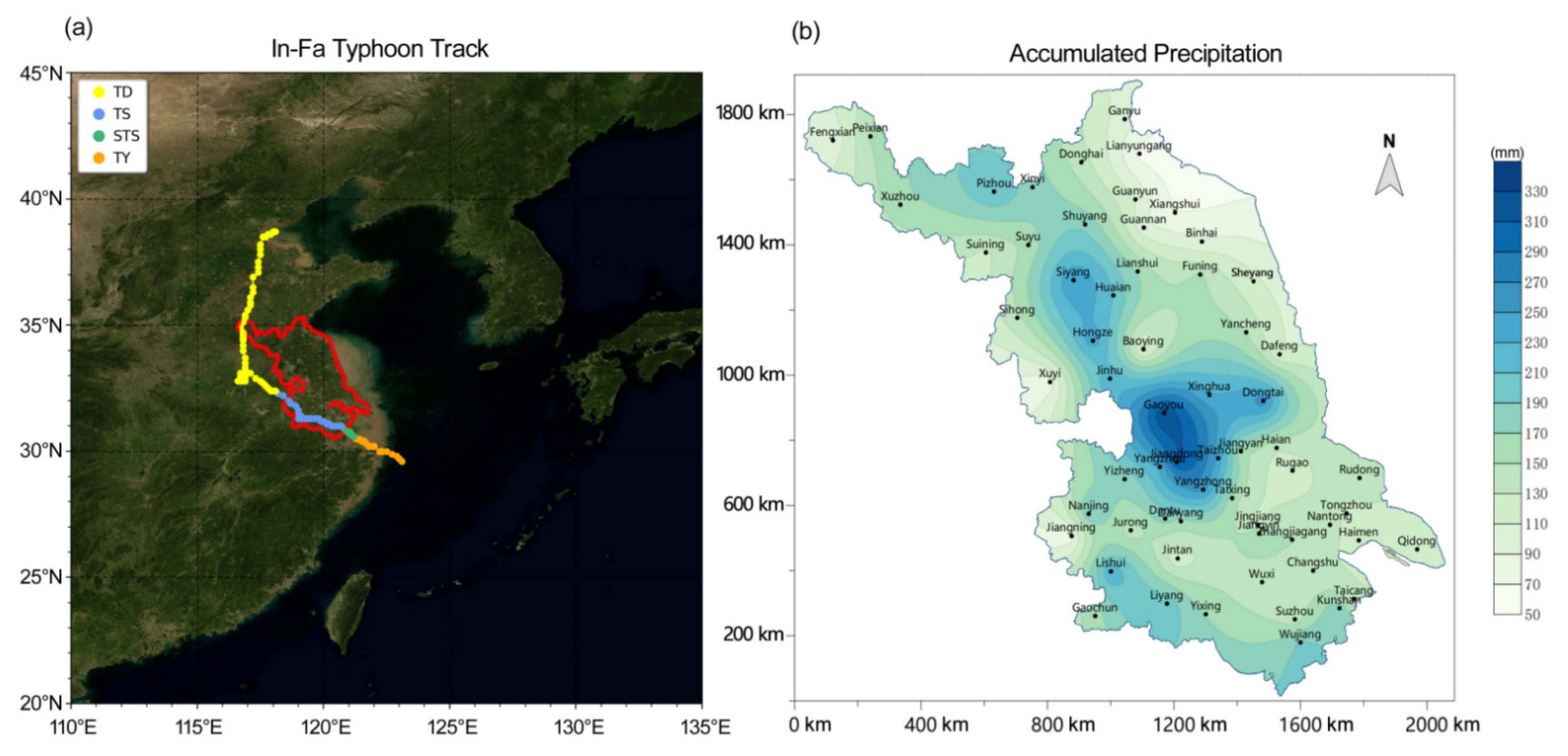

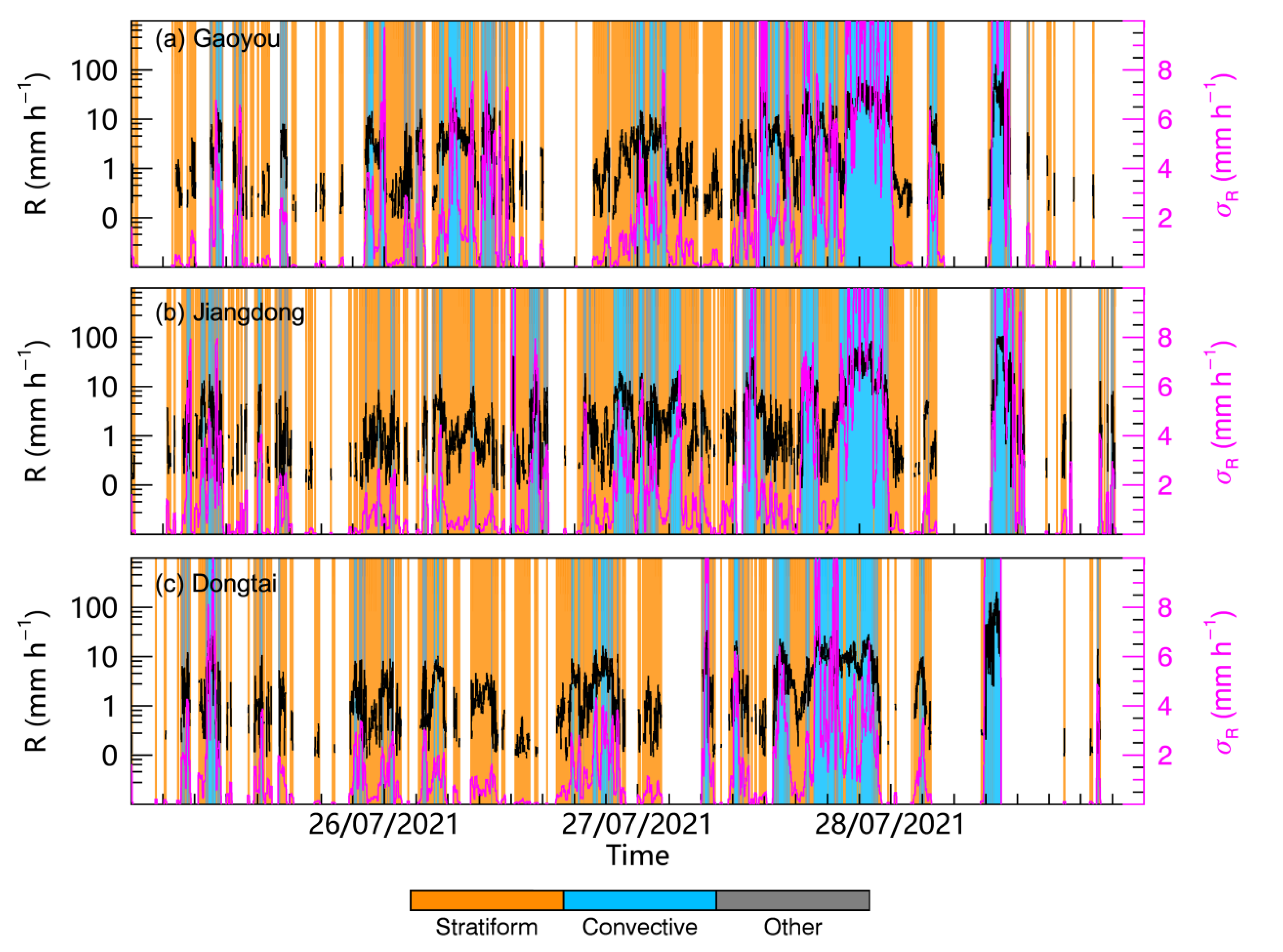

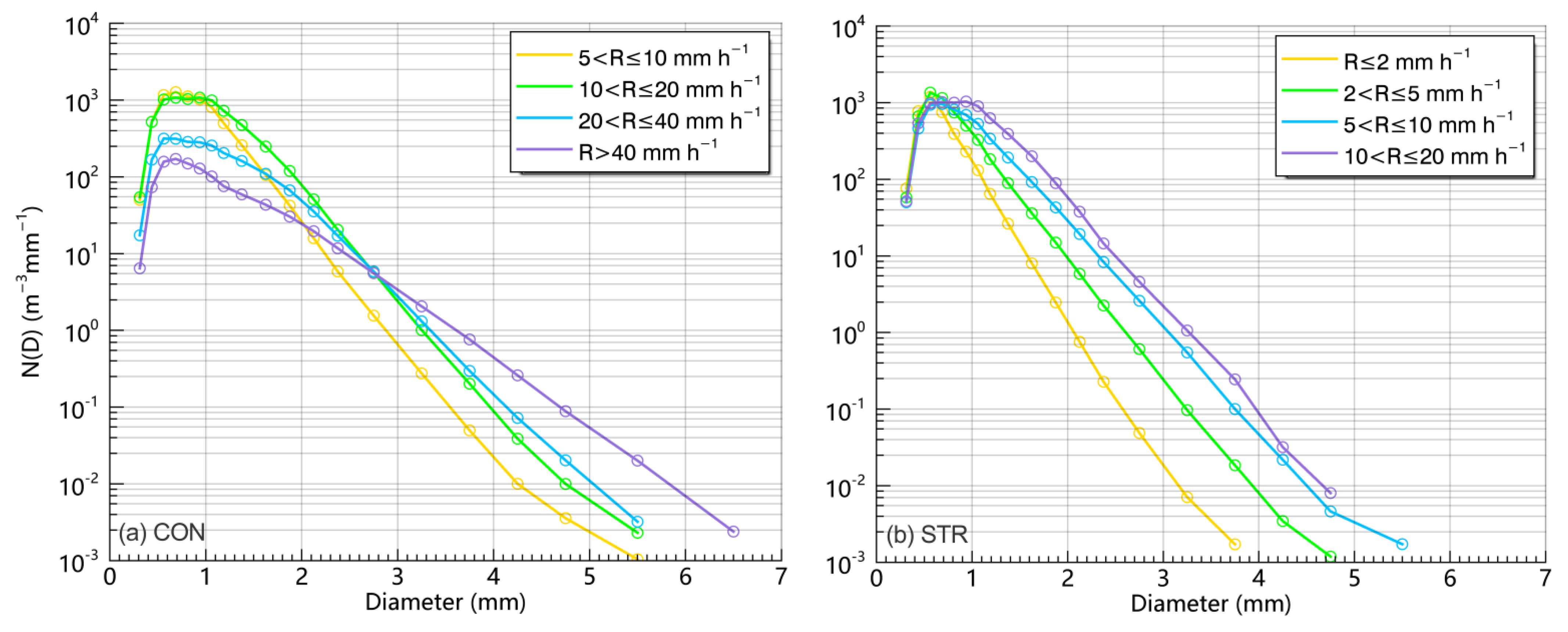
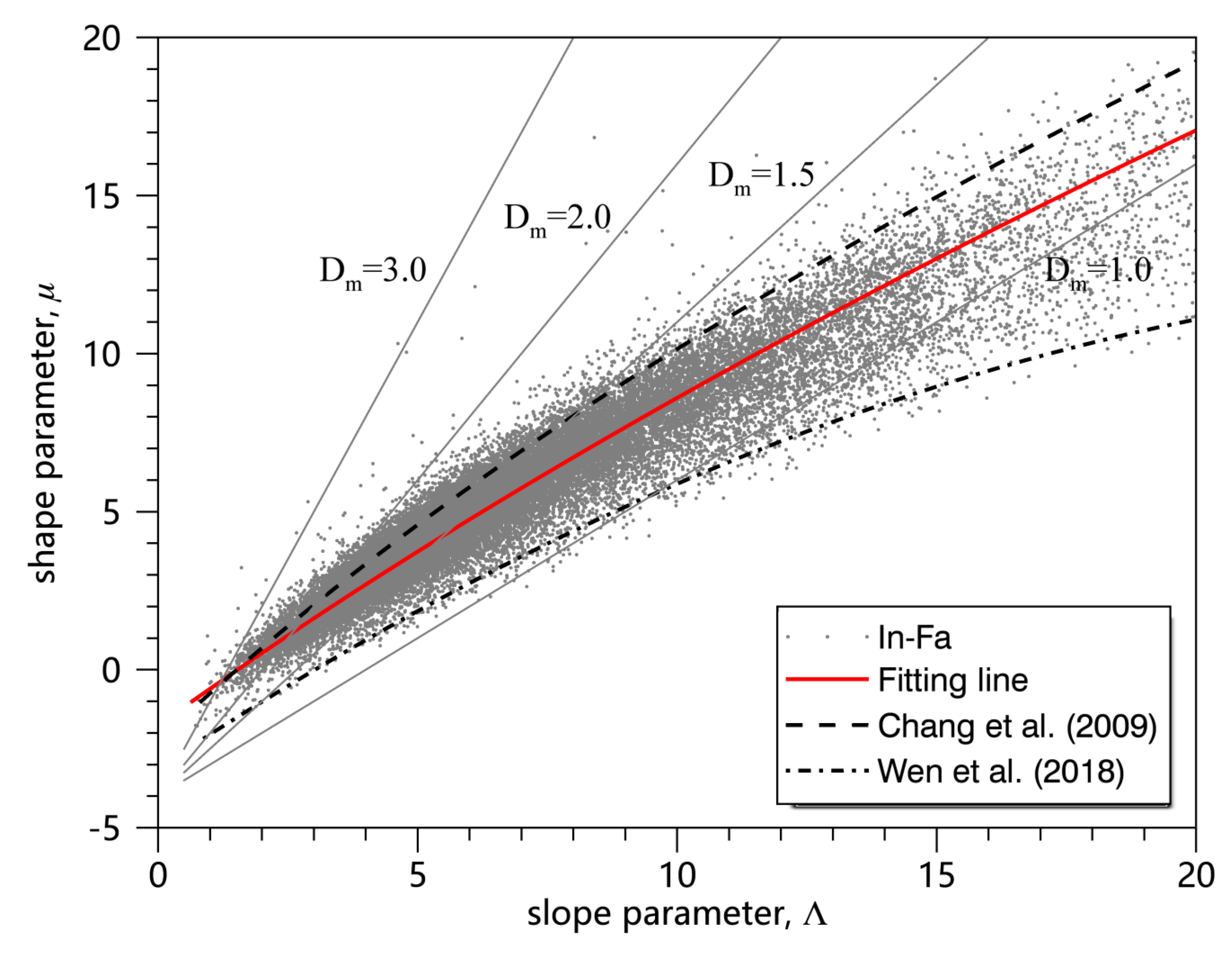
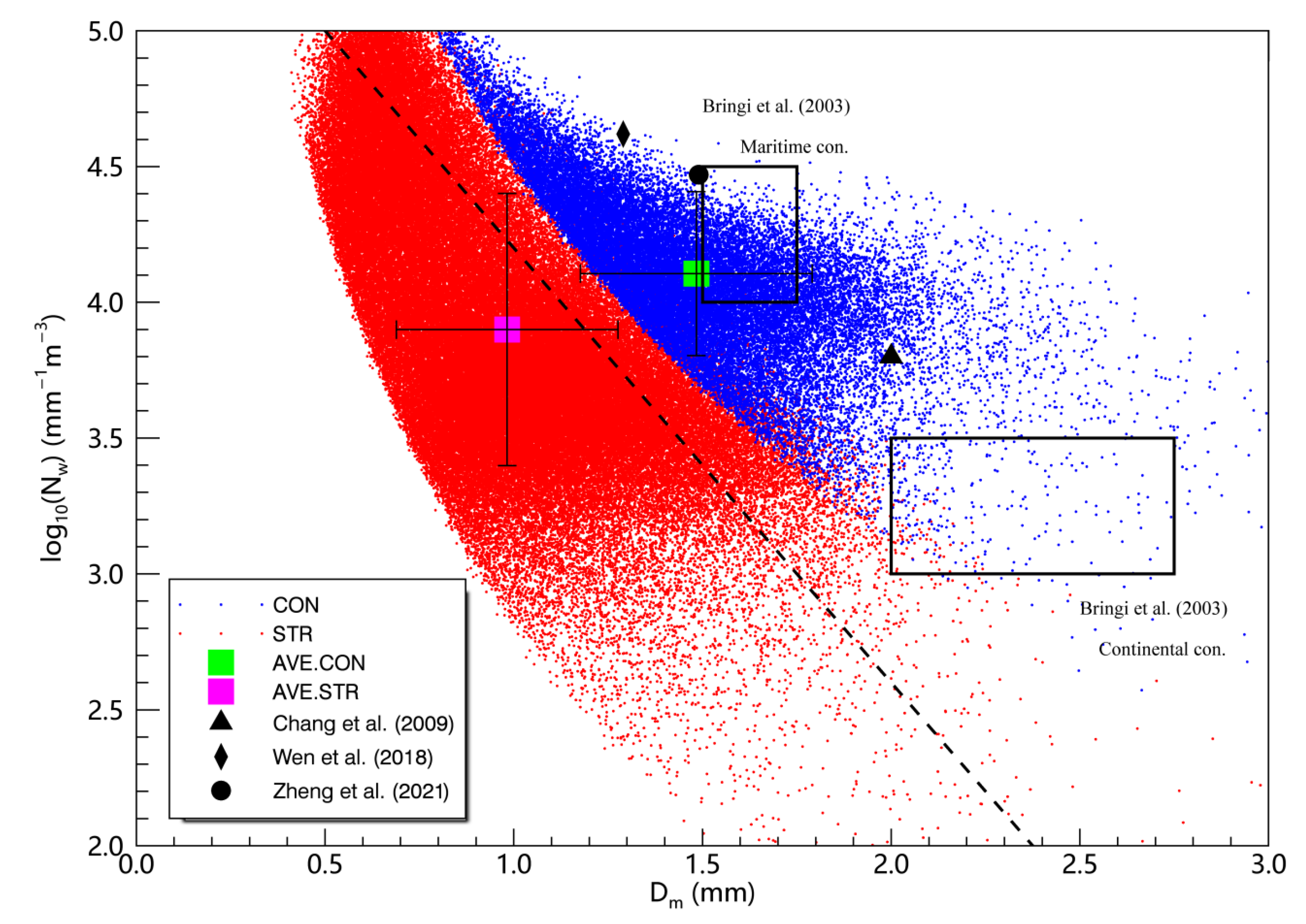
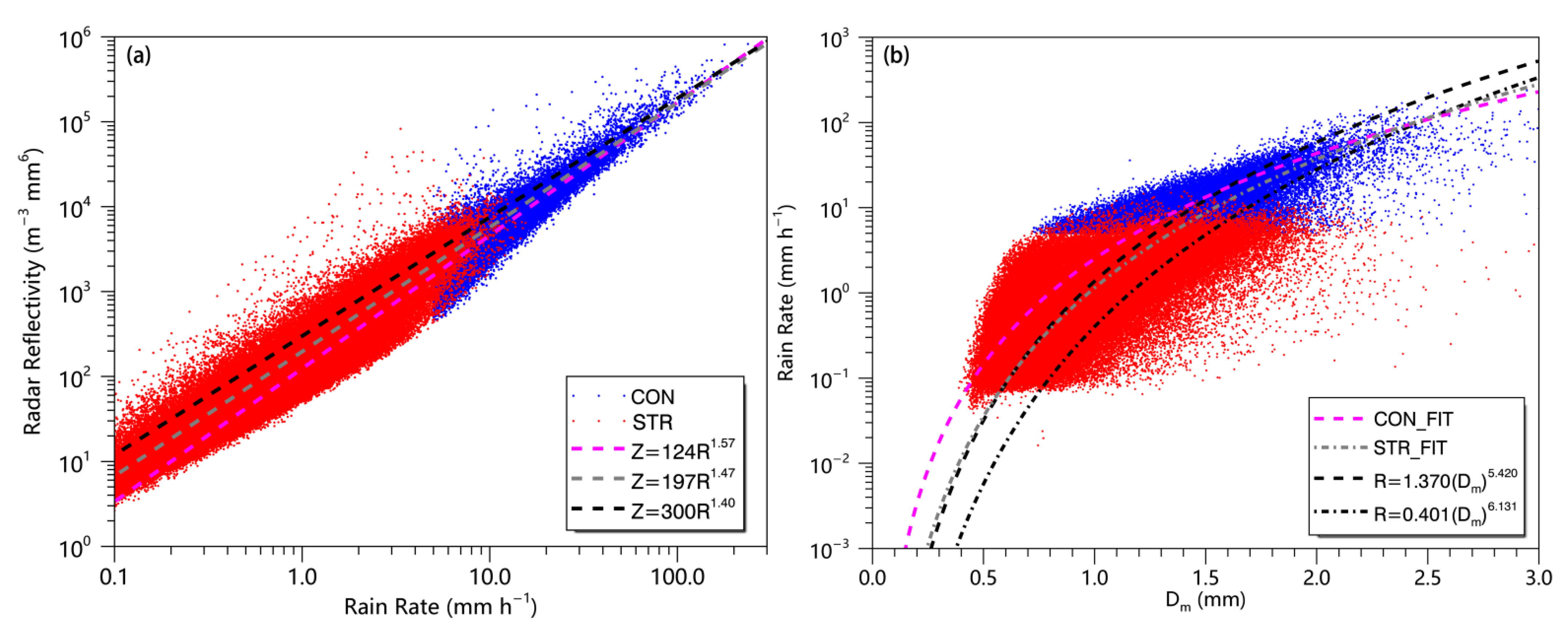
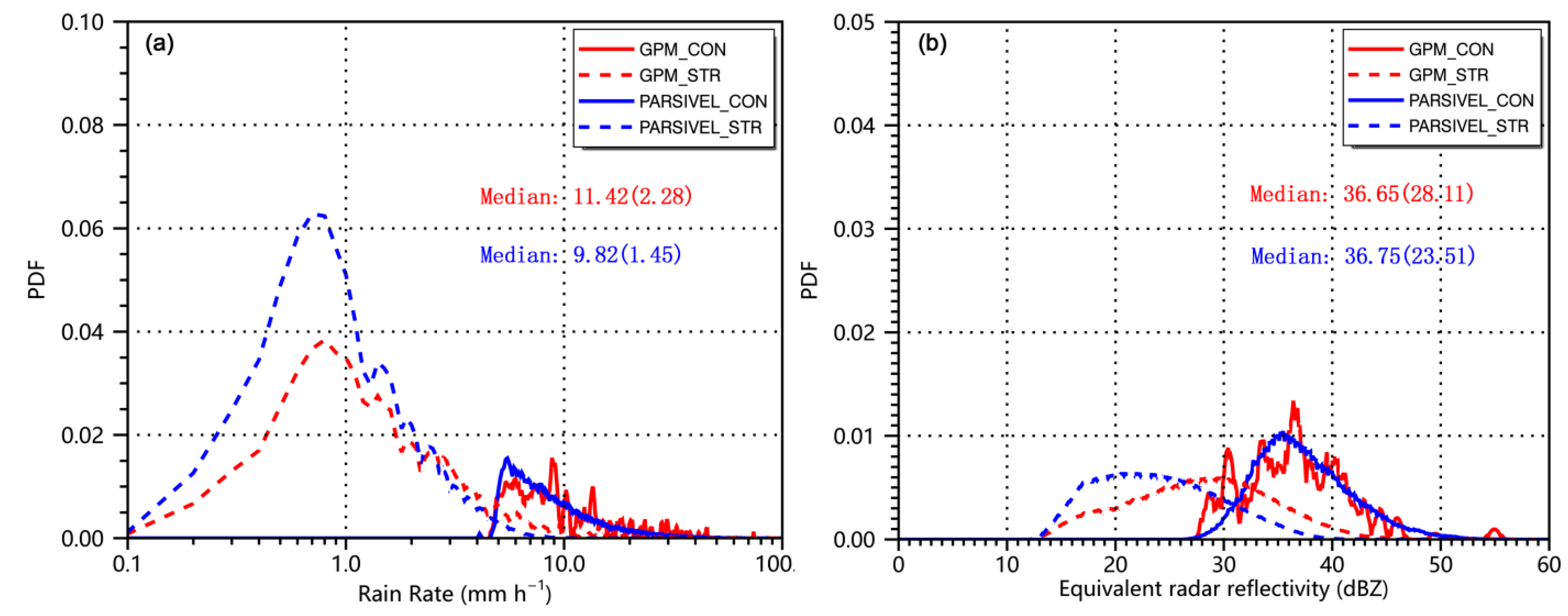
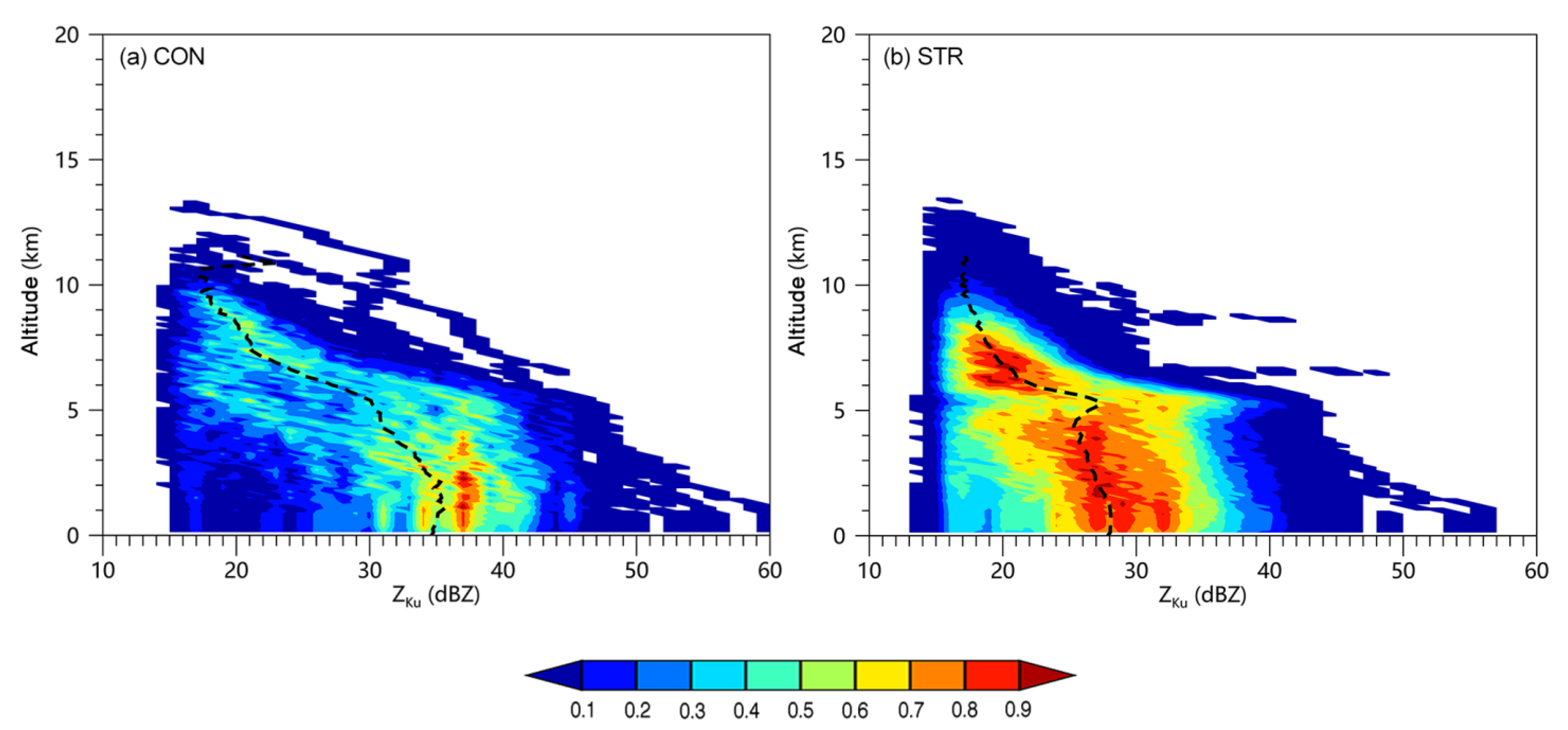
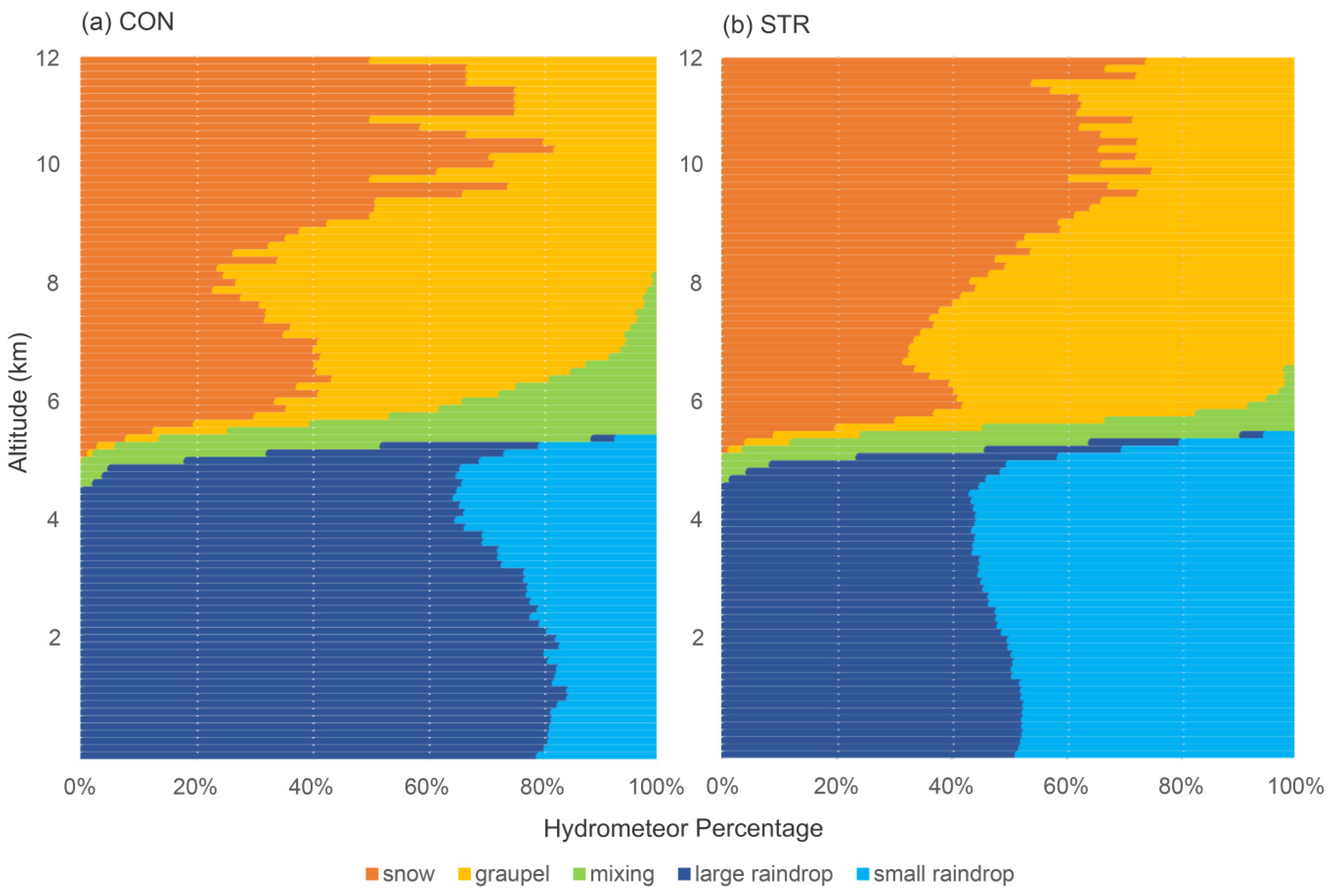

| Rain Type | R (mm h−1) | log10N0 (mm−1-μ m−3) | μ (Dimensionless) | Λ (mm−1) |
|---|---|---|---|---|
| Convective | 5 < R ≤ 10 | 6.72 | 6.87 | 8.83 |
| 10 < R ≤ 20 | 5.84 | 5.66 | 6.60 | |
| 20 < R ≤ 40 | 5.05 | 4.19 | 4.69 | |
| R > 40 | 4.42 | 2.16 | 2.96 | |
| Stratiform | R ≤ 2 | 10.24 | 11.77 | 18.83 |
| 2 < R ≤ 5 | 7.35 | 7.49 | 11.08 | |
| 5 < R ≤ 10 | 5.67 | 5.04 | 6.84 | |
| 10 < R ≤ 20 | 5.84 | 5.53 | 6.72 |
| Relation | Rain Type | a | b |
|---|---|---|---|
| Z = aRb | Convective | 124.2 | 1.567 |
| Stratiform | 196.6 | 1.465 | |
| R = aDmb | Convective | 2.513 | 4.109 |
| Stratiform | 1.146 | 5.011 |
| Rain Type | GPM Sample Quantity | PARSIVEL Sample Quantity | NB (%) of Rain Rate | NB (%) of Radar Reflectivity |
|---|---|---|---|---|
| Convective | 379 | 30515 | 16.3 | −0.27 |
| Stratiform | 2436 | 107203 | 57.2 | 19.6 |
Publisher’s Note: MDPI stays neutral with regard to jurisdictional claims in published maps and institutional affiliations. |
© 2022 by the authors. Licensee MDPI, Basel, Switzerland. This article is an open access article distributed under the terms and conditions of the Creative Commons Attribution (CC BY) license (https://creativecommons.org/licenses/by/4.0/).
Share and Cite
Wu, Z.; Zhang, Y.; Zhang, L.; Zheng, H.; Huang, X. A Comparison of Convective and Stratiform Precipitation Microphysics of the Record-breaking Typhoon In-Fa (2021). Remote Sens. 2022, 14, 344. https://doi.org/10.3390/rs14020344
Wu Z, Zhang Y, Zhang L, Zheng H, Huang X. A Comparison of Convective and Stratiform Precipitation Microphysics of the Record-breaking Typhoon In-Fa (2021). Remote Sensing. 2022; 14(2):344. https://doi.org/10.3390/rs14020344
Chicago/Turabian StyleWu, Zuhang, Yun Zhang, Lifeng Zhang, Hepeng Zheng, and Xingtao Huang. 2022. "A Comparison of Convective and Stratiform Precipitation Microphysics of the Record-breaking Typhoon In-Fa (2021)" Remote Sensing 14, no. 2: 344. https://doi.org/10.3390/rs14020344
APA StyleWu, Z., Zhang, Y., Zhang, L., Zheng, H., & Huang, X. (2022). A Comparison of Convective and Stratiform Precipitation Microphysics of the Record-breaking Typhoon In-Fa (2021). Remote Sensing, 14(2), 344. https://doi.org/10.3390/rs14020344






